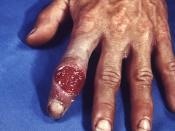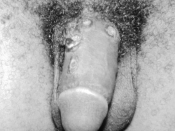Syphilis is a serious sexually transmitted disease (STD) caused by the
bacterial Treponema pallidum. It is often been referred to as "the great
imitator" because so many of the signs and symptoms are similar to those of
other diseases. The time between infection with syphilis and the start of the
first symptom can range from 10-90 days. Stages of syphilis are very distinct
they include primary syphilis, secondary syphilis, latent syphilis, and late
syphilis.
The primary stage of syphilis is marked by the appearance of a single
sore known as a chancre, however there might be multiple sores. It appears
at the spot where syphilis enters the body, which may be a place where it is
not noticeable. The chancre is often firm, round, small, and painless. In 3-6
weeks, the chancre will heal by itself. If it remains untreated, the infection
progresses to the secondary stage.
The secondary stage of syphilis begins once one or more areas of the
skin breaks into an itch less rash.
This rash appears rough and can be a
reddish or brown spot, which is usually located on the palms or on the soles
of the feet. The rash can spread to other parts of the body, with
characteristics resembling other diseases. Like a chancre in the primary stage
of syphilis, these rashes, even without treatment will clear up on their own.
A fever, sore throat, headaches, joint pains, poor appetite, weight loss, and
hair loss accompanies this rash.
In the latent or hidden stage of syphilis, symptoms may disappear for
years. Most people have no symptoms in this stage, but a few may develop
painful lesions called gummas in bones, skin, nervous tissue, and the heart.
During this stage the bacteria begins attacking internal parts of the body,
including the brain, nerves,


